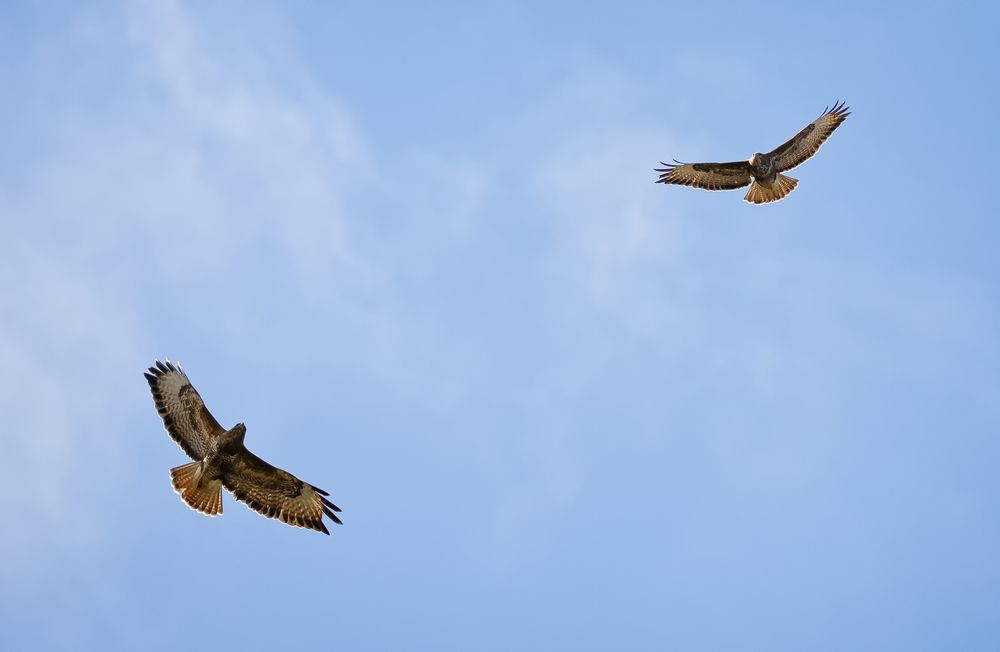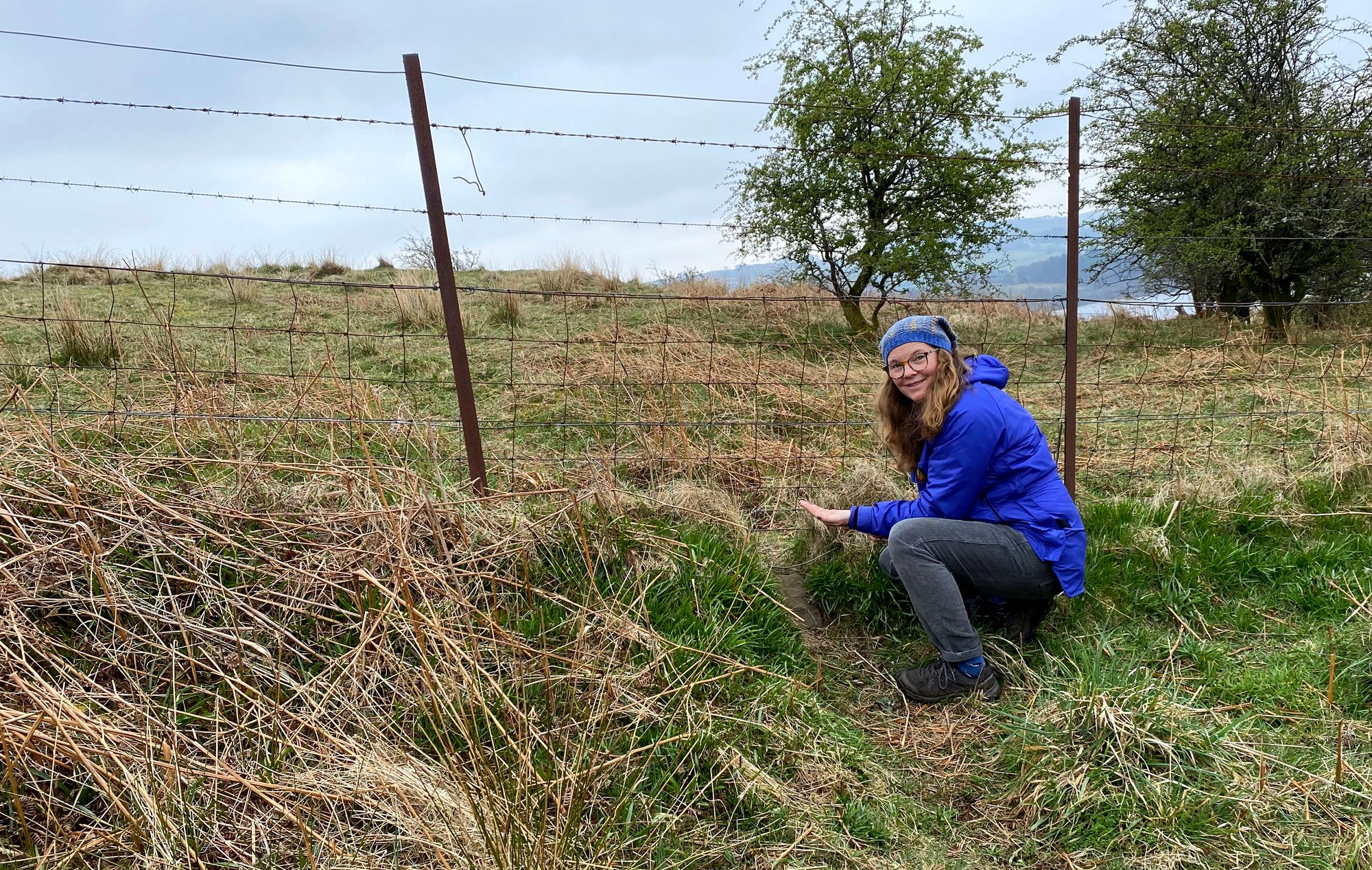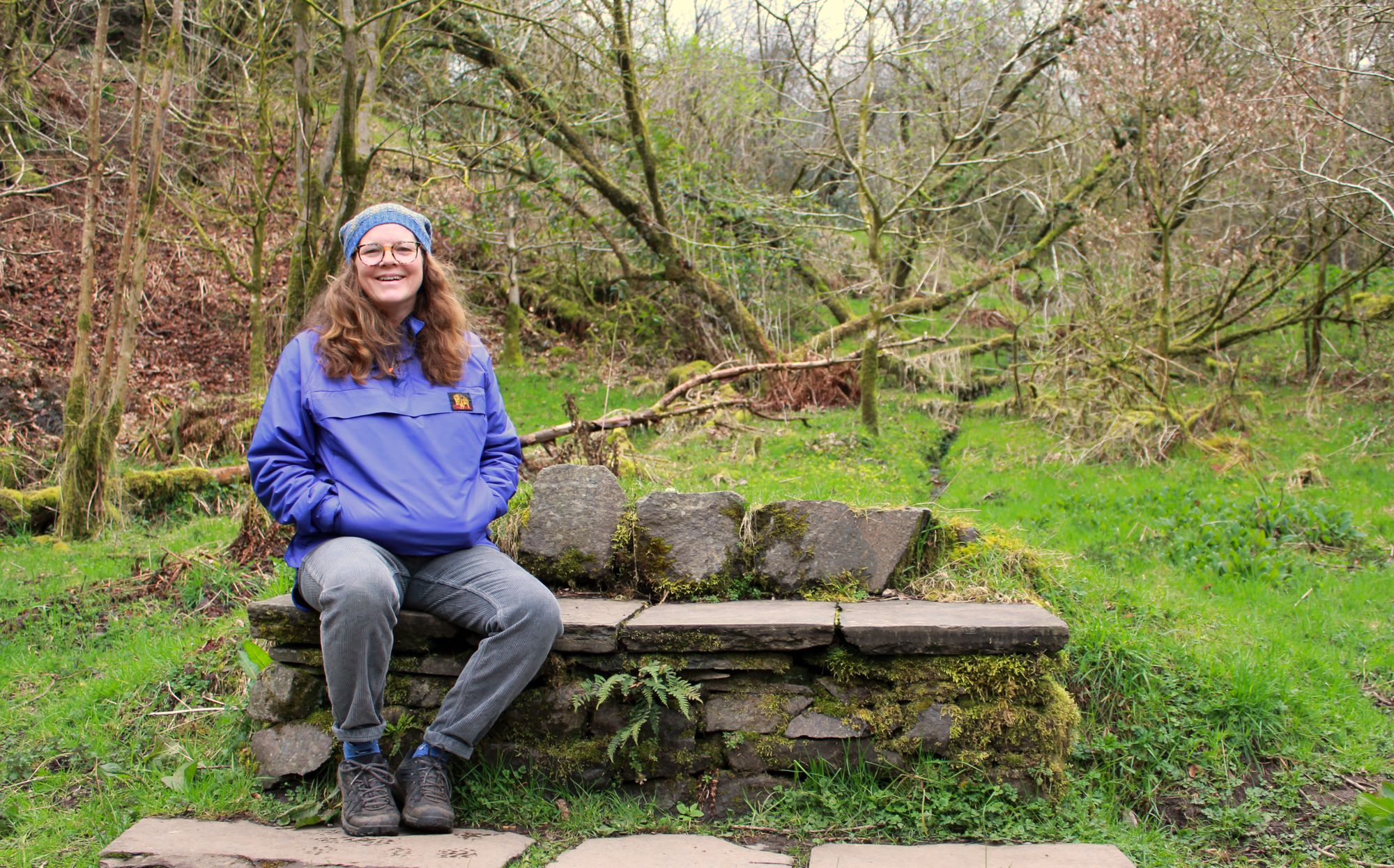Diane spots a long-tailed tit watching us along the trail and stops suddenly. “Peesh, peesh, peeshhhhhh,” she projects towards the tiny bird, repeating the sound with a confident rhythm. I’m completely fascinated by what’s happening. The long-tailed tit, which is normally a very shy bird, is bouncing from branch to branch among the hawthorn and birch trees. I can see the beginning of tiny buds – the hawthorns are coming into leaf. The tiny long-tailed bird is clear and brave ahead of us, showing himself as a distraction. It’s breeding season, and he is protecting his nearby nest by drawing our attention away from it. It’s working – we are entranced by this gorgeous bird.
“They make beautiful nests out of feathers and spiders' webs,” Diane tells me between peeshes. The long-tailed tit’s mate appears, and a succession of alarm calls are sent out in response to our presence. “That peeshing is a bird survey technique. The high pitch of the peesh tends to get the little birds out to have a look at you. The pitch mimics the alarm calls of small woodland birds, like chaffinches, robins and tits,” she says.
Bird surveys are a core part of Diane’s work as an ecological consultant with Starling Learning, which is an ecological consultancy, environmental education, and conservation management agency based in west central Scotland. Bird breeding season is the busiest time of the year for Diane, and we have squeezed in a woodland walk, to talk about her career and what it’s like working in conservation.
Getting up before the birds
Diane’s job is varied. One week she is on the Isle of Arran, watching hen harriers hunt meadow pipits, and golden eagles soar through the Clauchan Glen. The next she is using a mini-digger to dig out a small pond and create a habitat for rare mud snails, on a tiny peat-bog surrounded by housing estates in East Dunbartonshire. As well as ecological surveys and practical conservation work, Diane delivers environmental education sessions to schools and community groups, and on our walk it certainly feels like I’m getting an education. From the reed bunting she spotted when we first arrived, to the coaxing of the long-tailed tits to show themselves to us on the trail, I’m feeling wiser and more excited about the wildlife around us than ever before.
"The vast majority of the time, it's amazing," she says. "A lot of the time, it's really hard graft. It's your mental stamina that keeps you going."
Starling Learning does a lot of surveys for wind farms, but Diane’s latest work involves visiting 23 sites through April, May, and June to conduct breeding bird surveys as part of a project to update the Sites of Importance for Nature Conservation (SINCs) for East Dunbartonshire Council. “This involves getting up at half past four in the morning,” says Diane. “It’s glorious. You need to get there before the birds are waking up, because some birds will sing really, really early and then have a bit of a rest.” Everything that Diane and her colleagues see will be mapped and plotted, and each SINC site will get a biodiversity score. “So if it’s got a breeding badger sett in it then it gets a higher score, for example,” she says.
Surveying is not always glorious work, Diane tells me. The cold days can be the toughest: “It can be freezing, there’s snow on the ground, and you’ve got to sit for five hours and observe.” She has all kinds of battery-powered heat packs to keep her going, and physical work keeps her warmer: she could be up on a moorland putting in bog blocks, or at a site planting trees, or hedge laying. Diane loves being outdoors and doing physical work, but sometimes it’s really tiring and energy can dip. Mini-diggers get stuck in the mud. The cold makes a minute feel like an hour. “The vast majority of the time, it’s amazing,” she says. “A lot of the time, it’s really hard graft. It’s your mental stamina that keeps you going.”
Diane's 5 top tips for new ecological surveyors
If you’re a newly trained ecologist about to embark on your first ecological survey, you’ll know it can feel both exciting and daunting, as there are lots of skills still to learn. Not everyone at your survey locations will be as excited about protecting wildlife as you are – and that’s OK! If you have a passion for the job and commit to building your skills, you already have the right toolkit for becoming an ecologist who can confidently advocate for wildlife. On that note, Diane shares some more useful tips below!
1. Know your stuff
The first thing on your agenda should be building your knowledge of wildlife, habitats, and the law. Use your free time to get outdoors, read books, read scientific papers or blogs, and stay on top of the latest legal developments. When you know the law is behind you, you’ll feel confident about what to put in your report, and what to say to people at your survey site. As your knowledge grows, you’ll get more of a feel for different habitats, like moorlands or woodlands. Before too long, you’ll be walking in a woodland in springtime, you’ll see a conifer, and you’ll know it's likely that there are breeding goldcrests up there.
2. Have the courage of your convictions
As you gain expertise, your ability to advocate for wildlife will grow too. Have the courage to stand up for what you know. When you are at a survey site, perhaps dealing with people who do not have much experience with ecology, do your best to enthuse about wildlife. Emphasise the value and the importance of it, and be excited about what you see! A big part of your job is to bring people over to your side. On a similar note, never be afraid to raise your concerns where you feel it’s necessary. You are there to speak for the habitats, animals, and plants that don’t have a voice, so speak up!
3. Build relationships
One of the more challenging parts of the job is learning how to stand up for wildlife, whilst also building relationships at survey sites. Ideally, you want the people you’re working with to be interested in what you've found and in what’s going on. It’s also important, however, to set boundaries, like in any professional relationship. Be clear about what you can and cannot do – this allows you to maintain good relations with people, because they know what to expect.
4. Don’t expect to know everything
Biodiversity is a never-ending subject. You’re not going to have an all-encompassing knowledge – someone could study earthworms for 30 years and still have lots to learn! It’s helpful to recognise this early on, and not put too much pressure on yourself.
5. Ask for support when you need it
When you’re new in the role and don’t have many hours of field experience under your belt, it’s important to ask for help, rather than pretending to know stuff when you don’t, as this can end up harming wildlife. Speak up when you don’t understand something, or when you need help from a colleague.
We’re on an easy walk today through the mixed woodland by Lochwinnoch, a village which lies about halfway between Glasgow and the west coast. It's on the edge of Clyde Muirshiel Regional Park, an area of around 28,000 hectares of land, within which is Waterhead Moor in the Renfrewshire Heights (one of only three designated Wild Land Areas south of the Highland Boundary Fault). The open moorland has small hills and steep glens, and from the highest points there are clear views of the Firth of Clyde, and the Isle of Arran to the south west.
Environmental education
Our woodland walk lies at the base of the moorland, the air is damp and the trees are thickly dressed in moss. The understory shows signs of spring, with bluebells emerging, dog’s mercury springing to attention, and patches of wood anemone flowers catching the light. We’re here because Starling Learning are based in Lochwinnoch, and so is Diane. "I work an average of 3 days a week," she says, and she has worked part-time since she started her ecological career after having her first child. "I’m really lucky, because part-time opportunities within this sector can be thin on the ground."
"Social inclusion is something that's talked about in conservation, but a lot of people have no idea what that really means."
One of Diane’s favourite aspects of the job, and the role she first took on 17 years ago, is environmental education. "I absolutely love it," she says. "I think the skill that we have as an organisation is that we’re actually really good ecologists – we really know what we’re talking about." When Diane first joined Starling Learning, they were delivering education at the RSPB Lochwinnoch reserve. Kids from surrounding areas or inner city schools, quite often from areas of serious deprivation, would be seeing birds like robins for the first time.
"Social inclusion is something that’s talked about in conservation, but a lot of people have no idea what that really means," explains Diane. "I really believe in environmental education. It can transform lives." She experienced first-hand how much of a leveller environmental education can be. Teachers would warn her about the behaviour of certain children. In the outdoors, looking at the birds and plants, she saw that the children who had been labelled as disruptive were taking part and excited to learn. "Maybe there’s a kid who can’t sit still in class, and doesn’t perform well in maths and literacy, but when they’re outside and everyone’s the same, they get the chance to thrive and grow in confidence. They can build their resilience," says Diane. "I really believe that if environmental education was a priority in schools, all those skills could be taken back into the classroom."
"Witnessing two buzzards in the midst of pairing bond behaviour is rooted deeply in Diane's memory."
For Diane, encouraging people to observe and appreciate common wildlife is as important as experiencing the more rare species. Her own favourite moment happened at a quarry site near Lancaster: "I was right at the top of this big quarry and a pair of buzzards were displaying to one another – they went into a talon grasp. They flew right in front of my head and I watched them spin down to the bottom of the quarry as if they were going to hit the ground. They were just spinning and spinning. It was amazing to watch an ordinary bird doing something absolutely extraordinary."

Buzzards are the most common of our birds of prey in the UK, and they tend to mate for life. Witnessing two buzzards in the midst of pairing bond behaviour is rooted deeply in Diane’s memory. "Breeding season!" she exclaims. "It feels so dramatic and exciting. I love all the romance of it."
Patrol paths and career paths
We leave the woodland and walk up to a high point to look out over the three lochs below: Castle Semple, Barr, and Kilbirnie. When I first arrived, there were kids out in kayaks, taking their first strokes in the water, learning how to capsize safely for the season of loch recreation ahead. From up here, they are tiny dots in the water. Diane points out the RSPB reserve at Barr Loch in the distance.
Diane admits that she couldn’t have knitted herself a better job. The location, the hours, and – most importantly – the work, are more than she’d hoped for. "How did I get into this?" She ponders my question for a moment and then is off.
"Here’s a badger’s patrol path!"

"Wooosht!" She draws a line with her finger along the trajectory of the path coming out of the woods and crossing under a fence into the open grassland. Dried bracken and willowherb stems are crushed underfoot. "It’s a badger highway!" says Diane.
She follows the path and leans down by a gap under the fence looking for badger guard hairs – the tough hairs at the back of a badger’s neck – which get easily caught. They’re distinguished by their black, white, black colouring and angular shape. Diane tells me to roll one between my finger and thumb to feel the squared edges. "Look at all this hair," she says. "The young have emerged from their dens. They’re making sure that a rival clan doesn’t come in. They patrol their paths and scent mark, and there will be latrines at different spots around here to let other badgers know that this is their patch."
We examine the fence and admire the path, and take time to look closely at the coarse hairs. We share in the joy at finding these indicators of the ordinary cycle of the badger’s nightly routine.
"Where were we?" says Diane as we rejoin the trail.
"A chance encounter with an old school friend, Joe Greenlees, who works with Starling Learning, led her to find out about a job opening. She had a conundrum: should she go back and do her fourth year of the degree or apply for the job?"
After school, Diane worked in catering. It was a career path that was in her family, but it wasn’t her passion. She had been running a cafe in Glasgow when she decided to make the change and go to Auchincruive College in Ayr to study countryside management. She knew quickly that she’d made the right choice: "I was a proper boffin. I was so into it and thrilled to be there every day." At the end of the third year of her degree, Diane and her husband had their first son. A chance encounter with an old school friend, Joe Greenlees, who works with Starling Learning, led her to find out about a job opening. She had a conundrum: should she go back and do her fourth year of the degree or apply for the job?
"I had a mortgage and a baby, and had already been working part-time while studying. The job was based in the village where I live," says Diane. "So I didn’t do my Honour’s year, and I don’t regret it at all." Diane finished her maternity leave, started work as a field teacher, and gradually got into Starling Learning’s other areas of ecological work. "We’re quite small, we’re like a family. My boss, Liz Parsons, is a brilliant employer."
Finding a good mentor is about as difficult as finding your ideal job in the village you live in. Diane describes Liz as a fighter and a diplomat, and as someone who goes the extra mile to fight for wildlife: "I’ve never met anyone who advocates more for wildlife than Liz. She will stand up to anyone."
I hear stories of the relentless calls Liz made – and the construction company feathers she had to ruffle – to save two barn owls, which had been trapped in a construction zone by netting installed by a contractor. I hear about the way Liz uses humour, knowledge, and diplomacy to get hostile contractors on side at wind farms and construction sites, and how she stands strong in the trickiest of scenarios: "I’m fortunate that the person above me is modelling great things."
Getting people on side
"Not everyone working in conservation has the communications skills to match," explains Diane. "And being a woman on site is a tough gig."
Diane sees new ecologists being sent out to do surveys at building or construction sites, when they don’t yet have enough knowledge and courage to stand up for their convictions. What ecologists find on site will go on to inform the planning process, and if work is already underway, their findings can disrupt progress. "If a blackbird is nesting in a digger, you have to be able to bring the contractors over to your side," says Diane. "You have to convince them that all wildlife, from the golden eagle to the blackbird, is worth protecting."
"Every site and every species is important. If people can see that you know your stuff, your position is easy to defend because you have the law on your side."
Ecological consultants have a great deal of responsibility to protect our natural world, but their role and their knowledge is not always recognised on site: "Convincing them that ecology and the protection of wildlife are serious subjects is often the trickiest part of the job to get right. Every site and every species is important. If people can see that you know your stuff, your position is easy to defend because you have the law on your side."
As Diane tells me this, I’m slightly distracted because I’ve lost the badger hair I’d been carrying since we came across the patrol paths. I am a wildlife enthusiast, already convinced that our natural world is worth protecting, yet I’m still experiencing the impact that Diane’s enthusiasm can have on you. I want to read all about badgers when I get home. Diane has golden eagle pellets and "all kinds of other freaky things" collected in tubs, and I’m motivated to start my own collection with this badger hair I’ve now lost.
Diane’s presence must have a similar impact on many of the contractors, digger drivers, and wind farm engineers. Through her enthusiasm and knowledge, they can see that this connection is a good thing. "You’re always trying to build relationships so when you come over the hill to talk to them, they’re interested in what you have to say. Sometimes it’s like you’re giving them permission to reconnect with wildlife," she says. "They may not always feel that they’re allowed to admit that they like wee fluffy birds."
Engaging with communities
Having a passion for the job, keeping yourself informed, and having the courage to stand up for your convictions are essential attributes for the job. Diane and the team she works with have a strong commitment to advocating for wildlife. They believe in the positive impact that reconnecting people with nature can have on the wellbeing of communities and the environment. Starling Learning has joined forces with a local environmental social enterprise, Eadha Enterprises, to rewild the Renfrewshire Heights, the moorland above where we’re walking. The moorland may be a designated Wild Land Area, but its natural ecosystems have degraded over the decades, causing species loss and regular flooding in local communities as a result. "There can be a real dearth of species in some of these upland areas," says Diane. "You can go a whole day without seeing anything."
"Ecologists like Diane are guardians of the landscape, ensuring that a diversity of species can continue on their regular cycle each breeding season for generations to come."
By engaging with local farmers, landowners, schools, and the people living and working in the community, the Yearn Stane project team hope to restore much of the landscape, including the peat bogs, and to encourage a range of plant and animal life to return to the Heights. "We started the project in response to the fact that nothing will change unless we do it ourselves," says Diane. The team’s collective expertise, and their passion for protecting wildlife and connecting communities with the natural world, are propelling this project forward. Like the badgers patrolling their territory, the long-tailed tits protecting their nests, and the bluebells flowering and setting seed for another year, ecologists like Diane are guardians of the landscape, ensuring that a diversity of species can continue on their regular cycle each breeding season for generations to come.
Related articles
Considering getting into ecology? Find out all the essential info in these articles.
🍃 Check out our latest ecology and environmental education jobs!

